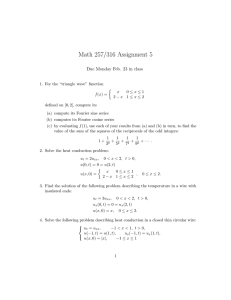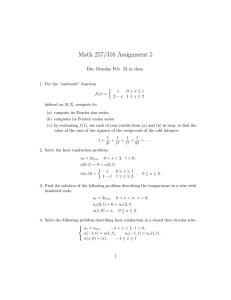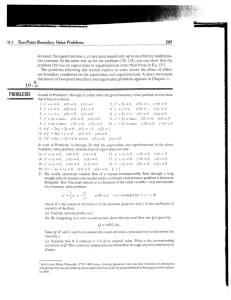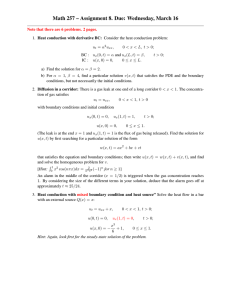Heat Conduction Robert Lochner Classical Mechanics PHGN 550 December 17, 2011
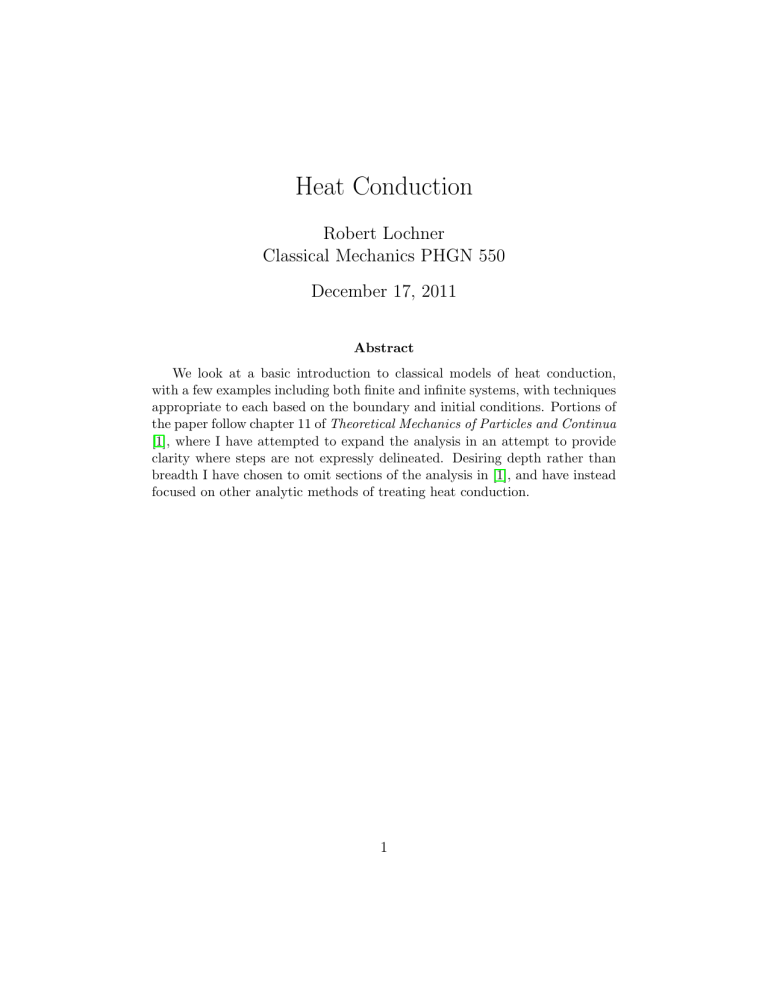
Heat Conduction
Robert Lochner
Classical Mechanics PHGN 550
December 17, 2011
Abstract
We look at a basic introduction to classical models of heat conduction, with a few examples including both finite and infinite systems, with techniques appropriate to each based on the boundary and initial conditions. Portions of the paper follow chapter 11 of Theoretical Mechanics of Particles and Continua
[1], where I have attempted to expand the analysis in an attempt to provide
clarity where steps are not expressly delineated. Desiring depth rather than
breadth I have chosen to omit sections of the analysis in [1], and have instead
focused on other analytic methods of treating heat conduction.
1
1 Basic Concepts of Conduction
A classical treatment of heat conduction might begin with the observed relationship that heat transfer rate, q , is directly proportional to the gradient of temperature, and that heat is transferred from a region of high temperature to a region of lower temperature.
q ∝ −∇ T
Further, we can also observe that q is directly proportional to the cross sectional area of a conducting material. And it can easily be seen that this transfer rate differs for different materials, so we might expect a coefficient describing the material to be included in our expression. Thus, with only three pieces of information, we can write a basic description of our understanding of what determines the rate of heat transfer in a material.
Figure 1: A sample in which a temperature difference drives a heat current from left to right, where
T
1
> T
2
.
q = − kA ∇ T
Where k is the thermal conductivity , which is a material property.
Instead of the heat transfer rate, we might wish to discuss the heat current , j h
.
Another name for the heat current is the heat flux, and defined in terms of our heat transfer rate q , j h
= q/A . Thus we can write j h as a function of T.
j h
= − k ∇ T (1)
This equation, where j h is sometimes denoted q
00
, is the differential form of
Fourier’s Law of thermal conduction . This law is phenomenological in that we have only stated what we can deduce from direct observation of simple heat transfer. To develop our insight further, we need to consider a few fundamental quantities involved in heat conduction, namely: temperature, internal energy, entropy, and pressure.
2
1.1
Basic Thermodynamics
1.1.1
Energy
Temperature, T , entropy, S , and pressure, p are characteristic of a system. If we consider a certain volume of a sample, then we also have a mass, m , and a volume v . Now if we consider the additional quantities W , the external work done on our volume, and the heat added Q , then we can write a relationship between the internal energy E and the quantities listed above. If we take the limit as our volume becomes infinitesimal, then we consider the infinitesimal quanties: dE, dS, dv, δQ, & δW With these quantities, we have all that is necessary to write the first and second laws of thermodynamics: dE = δQ + δW (2) and dE = T dS − p dv (3)
Where dE is the change in internal energy for for an elementary reversible process, and we assume that T(x), S(x) , and p(x) are all differentiable with respect to position within and local to our infinitesimal volume. The heat added, δ Q and the δ W are infitesimal quantities, though we make no assumptions about their position dependence, that is, we do not necessarily have a functional form for W and Q . Positive change for our variables describes an increase, and for our tiny sample, we assume reversibility because the differential changes are very small. Note the relationships suggested by the above equations in fact allow us to express δ Q and δ W in terms of quantities we can express in terms of functions.
δQ = T dS & δW = − p dv (4)
1.1.2
Enthalpy
Now if we introduce another quantity which is common in thermodynamics, we can write the enthalpy, H , as a function of E, p , & v by way of a Legendre transformation.
H = E + pv (5)
Taking the differential of this equation gives:
(6) dH = dE + vdp + pdv
Then substituting (3) and (4) into (6), get:
dH = δQ + v dp (7)
3
Considering a constant pressure system, (which is in practice easier to achieve in lab than is a constant volume system), we get dp = 0, giving dH = δQ .
Then recalling from thermodynamics, the heat capacity at constant pressure
C p can be written as:
δQ
C p
= dT p
(8)
Equivalently, we could use the relation dH = δQ to write the heat capacity in terms of the enthalpy, (or for that matter, entropy). However, since we are holding p constant, we write a partial derivative of H instead of dH .
C p
=
∂H
∂T p
(9)
We could then integrate (9) with respect to temperature to obtain
H ( T, p ).
H ( T, p ) = H ( T
0
, p ) +
Z
T
C p
( T
0
) dT
0
T
0
(10)
Then, considering that for many materials in the high temperature limit, C p stays relatively constant, (the point at which C p plateaus differs from material to material, but for example, lead does so above roughly 100 K), we can approximate C p as a constant for a given temperature range (providing it is
not too large). Then, (10) becomes:
H ( T, p ) ≈ H ( T
0
, p ) + C p
( T
0
) × ( T − T
0
) (11)
Now recall that we have been considering an infinitesimal volume dv in our analysis above. If we wanted to describe our system, we could begin by expressing the mass of our volume as dm , and writing that in terms of a mass density ρ . For the sake of simplicity, let us assume a uniform mass density ρ
0 and then get: dm = ρ
0 d
3 r (12)
With this relation, we can write our heat capacity also as a in terms of r .
C p
( T ) = c p
( T ) ρ
0 d
3 r (13)
Where c p
( T ) is the heat capacity per unit mass , also known as the specific heat capacity . Note that the temperature dependence of C p and c p is the same.
Using (13), we can then express our total enthalpy,
H tot
, of our macroscopic sample in terms of an integration over space.
H tot
=
Z
V
ρ
0 c p
( T ( r , t ) − T
0
) d
3 r + H tot
( T
0
, p ) (14)
4
Where we have allowed T to vary with position and time. We can then write
this equation using (12), which will give us and integration over our total mass
M.
H tot
=
Z
M c p
( T ( r , t ) − T
0
) dm + H tot
( T
0
, p ) (15)
Assuming that temperature fluctuations do not produce a change in the mass distribution, though they may change the volume and density, we can then
take the derivative of (15) to obtain the
equation of heat conduction .
dH tot dt d
= dt
Z
M c p
T ( r , t ) dm (16)
Then observing that dT
=
∂T
∂t
+ d r ∂T dt ∂ r
(17) dt
Then we might want to consider just a fixed position, in which case we may drop the second term in the right hand side of the above equation. Substituting
dH dt tot
=
Z
M c p
∂T
∂t dm (18)
Using our relationship (12), we can alternatively write:
dH tot dt
=
Z
V
ρ
0 c p
∂T
∂t d
3 r (19)
Now, considering what produces a change in enthalpy, it will be useful to speak of the relationship between Q and H , as generally heat is a more intuitively
grasped quantity. Looking back to (7), we see that if we hold pressure constant,
which we have been assuming, then δQ = dH . Now we would say that changes in Q are produced by either heat current , j h
, or by generation of heat in the interior of our sample M q ˙ , where ˙q is the heat generation per unit mass. With
this observation we may break up our integral from (19).
Z
V
ρ
0 c p
∂T
∂t d
3 r =
Z
V
ρ
0
˙
3 r −
Z d A · j h
We could also express this equation in terms of differentials.
(20)
ρ
0 c p
∂T
∂t
= −∇ · j h
+ ρ
0 q ˙ (21)
Recalling from section 1, we already have an expression for the
heat flux , j h
.
Substituting (1) into our above equation get:
∂T
∂t
=
1 c p k ∇ 2
T
ρ
0
(22)
5
If we define a quantity, the thermal diffusivity, κ , as κ ≡
ρ
0 k c p
, and treat it as a constant, then we have the basic equation of heat conduction in solids , also known as the diffusion equation .
∂T
∂t
= κ ∇ 2
T + q ˙ c p
(23)
2 Separation of Variables
Recall that in the previous section, we wrote T as a function of time and position. If we assume that T is separable, then we get:
T ( r , t ) = T ( r )Γ( t ) (24)
If we assume an exponential time dependency ( i.e. Γ( t ) = e
− λt
, λ = const.
),
then plugging back in to (23) yields a relation which we can express in the
form of a Helmholtz equation.
∇
2
+ γ
2 q ˙
T ( r ) = −
κc p
(25)
Where,
γ
2
≡
λ
κ
(26)
Figure 2: A prism with ends held to a constant
T
and the sides thermally insulated
Let us consider a rectangular prism with dimensions a × b × c of some material with a constant thermal diffusivity, κ , for which there is no interior
6
heat generation and two opposing sides are held at a constant temperature T
0
, while the four remaining sides are thermally insulated. Now, if we imagine there is an initial inhomogenous temperature distribution, f ( r ), throughout our sample, then we might investigate the time behavior of our system as it equilibrates. Considering that there are two heat reservoirs of T
0 on each end, it is clear that as t → ∞ , then T → T
0
. Now, to describe this system we would like to write out T ( r , t ). To solve for T , it will be useful to consider the quantity:
δT ( r ) = T − T
0
This is the difference between T and T
0 as a function of position. If we imagine our prism with a coordinate system at one corner as shown, then δT (0) = 0, and we will say δT ( a ) = 0, where a is the x-coordinate of one end held to T
0
.
If we take T ( r = δT + T
0
, and substitute into our differential equation (25),
then since T
0 is simply a constant, we get:
∇
2
+ γ
2
δT ( r ) = 0 (27)
Let us write our boundary conditions out, which are clear given our constraints.
δT = 0 for x = 0 and x = a
∂
∂y
δT = 0 for y = 0 and y = b
∂
∂z
δT = 0 for z = 0 and z = c
If we then assume that δT ( r ) is a separable function, we have:
δT = X ( x ) Y ( y ) Z ( z )
Thus, using this relationship, we can write (27) as a simple O.D.E. for each
X, Y, & Z .
X
00
( x ) = − γ
2 x
X ( x )
Y
00
( y ) = − γ
2 y
Y ( y )
Z
00
( z ) = − γ
2 z
Z ( z )
Where,
γ
2
= γ
2 x
+ γ
2 y
+ γ
2 z
(28)
It is readily seen that sinusoids are solutions to these equations, and then
7
matching the boundary conditions, we get: mπx
X ( x ) = A sin γ x x = A sin
Z ( z ) = C cos γ z z = C cos a nπy
Y ( y ) = B cos γ y y = B cos b pπz c
Where m ∈
N while { n, p ∈
Z
| n, p ≥ 0 } . Thus, comparing the arguments of
the trig functions above, we may use (28) to write out allowed values for
γ .
γ
2 mnp
= mπ a
2
+ nπ b
2
+ pπ c
2
(29)
Then, recalling (26) we can obtain the general solution through linear com-
bination, (where we combine the constants of X ( x ) , Y ( y ) , and Z ( z ) into one constant. Note that C mnp
= C ).
δT ( r , t ) =
∞
X m,n,p =1
C mnp sin mπx cos a nπy b cos pπz e
− γ
2 mnp
κt c
(30)
When m = 0, the expression above is 0, and so it follows that we may sum from 1 → ∞ for all indices, and thus we have obtained the exact solution for conduction in our material with the given boundary conditions. Using the fact that T ( r , 0) = f ( r ), for time zero we have:
∞
X m,n,p =1
C mnp sin mπx cos a nπy b cos pπz c
= f ( r ) − T
0
(31)
From which we could determine the Fourier coefficients C mnp
, which would
complete equation (30) and allow us to write an explicit functional form of
T ( r , t ).
3 Fourier Transform (for an Infinite Domain)
In the previous section we worked with a sample of finite dimensions, however in some cases it may be useful to consider the case of an infinite domain, in which case we can make use of the Fourier transform.
F r
[ T ( r , t )]( k ) = ˜ ( k , t ) =
1
(2 π ) 3 / 2
Z
T ( r , t ) e
− i k · r d
3 r
8
Where we must have T → 0 as r → ±∞ . We also assumed that T ( r , t ) was separable, and if we take the form of the time dependence that we found in
˜
( k , t T ( r )Γ( t )
∂ t
˜
( k , t ) = ˜ ( r ) ∂ t e
− κγ
2 t
= − κγ
2 ˜
( r ) e
− κγ
2 t
= − κγ
2 ˜
( k , t )
Once again we will let f ( r ) be our initial condition (except now f ( r ) is defined over all space), and we can then obtain the initial condition for ˜ ( k , t ).
T ( r , 0) = f ( r )
F r
[ T ( r , 0)]( k ) =
F r
[ f ( r )]( k )
˜
( k , f ( k )
Thus it follows that
˜
( k , t ) = ˜ ( k ) e
− κγ
2 t
Taking the inverse Fourier transform, we get
T ( r , t ) =
F k
− 1
[ ˜ ( k , t )]( r )
1 Z
=
˜
( k , t ) e i k · r d
3 k
(2 π ) 3 / 2
Z 1
=
(2 π ) 3 / 2 f
˜
( k ) e
− κγ
2 t e i k · r d
3 k e
− κγ
2 t
=
(2 π ) 3 / 2
Z
= e
− κγ
2 t
Z
(2 π ) 3 d e
3 i k · r k
Z d
3 e k
Z
− i k · ( r − r
0
1
(2 π ) 3 / 2
) e
− i k · r
0 f ( r
0
) d
3 r
0 f ( r
0
) d
3 r
0
Observe that this last expression has the form of a Green’s function.
T ( r , t ) =
Z
G
( r − r
0
, t ) T ( r
0
, 0) d
3 r
0
(32)
Where
G
( r , t ) =
1
(2 π ) 3
Z e
− κγ
2 t e i k · r d
3 k
We could now solve explicitly for the Green’s function, and we would then
plug our solution back into equation (32) and integrate to obtain a final result
for T ( r , t ).
9
4 Alternative Approach for an Infinite Domain
An alternative approach to Fourier transforms and Green’s functions for dealing with an infinite domain begins with considering a semi-infinite solid, that is, a solid with one surface and extending infinitely from that surface. Due to the symmetry this system has, we really only need one dimension to describe the temperature distribution, given a uniform boundary condition at the surface. If we let x be the depth into the surface, we then choose boundary conditions.
T (0 , t ) = T s
(33)
T ( x, 0) = T i
Where T s is the surface temperature, which we will hold fixed by an inexhaustible reservoir, and T i is the interior temperature such that T ( x → ∞ , t ) =
T i
. Thus, we will have no heat generation ˙ within the solid. We will suppose that T s
= T i
, since else there would clearly be no heat transfer. Now, to find the temperature distribution as a function of time, we will look back to
∂T
= κ ∇ 2
T (34)
∂t
Now we can introduce a similarity variable η ≡ x/
√
4 κt , which allows us to transform our partial derivatives of x and t as partials with respect to η alone.
∂
∂T
∂x
2
∂x
T
2
∂T
∂t dT ∂η
=
= dη ∂x
√
1
4 κt dT dη dT ∂T
=
= dη ∂x
√
1
4 κt dT ∂η d
2
T dη 2
=
= dη ∂t
2 t
− x
√
4 κt dT dη
∂η
∂x
Substituting these new differential operators into (34) gives
d
2
T dη 2
= − 2 η dT dη
(35)
We now observe that our boundary conditions remain the same, and we conclude that η is indeed a similarity variable and we may write T as a function
10
of simply η . When we solve this function, we find
T ( η ) = C
1
Z
η e u
2 du + C
2
0
(36)
Where u is a dummy variable for integration. Now, using the boundary condition at η = 0, we find C
2
= T s
. For η = ∞ we obtain
T i
= C
1
Z
∞ e u
2 du + T s
0
(37)
Which gives
C
1
= √
π
( T i
− T s
) (38)
Thus we may write
T ( η ) =
2
√
π
( T i
− T s
)
Z
η
0 e u
2 du + T s
Or alternatively
T − T s
T i
− T s
=
2
√
π
Z
η e u
2 du ≡ erf( η )
0
Which behaves exactly as we would expect, because as η → ∞ , the error function approaches unity, or in other words, T → T i
. As t → ∞ , we observe that η → 0, and in that case T → T s
, which makes sense because we have stipulated that our surface temperature is fixed, and thus we would expect as time continues that our solid begins to equilibrate with the surface (i.e.
T i
→ T s
). Thus we have demonstrated another way of calculating how heat is transported (by looking at T ( t )), although we looked at an ideal system, and this method does not have a great deal of flexibility or applicability to other problems. However, given a set of boundary conditions, in some cases it is possible to begin with Fourier’s Law , (as we did in this problem) and to obtain an analytic solution.
5 Conclusion
We have looked at a few ways of going about solving heat conduction problems from a classical viewpoint. For systems different than those we looked at, we may need additional tools, but we have explored a few of the basics here. In
conclusion, it is important to recall from section 1.1 that the principle concept
behind heat conduction is conservation of energy. The other very important piece of information with regard to heat conduction is the diffusion equation
11
(23), which allows us to use our empirically derived knowledge to obtain a dif-
ferential equation describing the time and position evolution of a temperature distribution. Beyond those concepts, as was somewhat apparent in our analysis, much of the heat conduction analysis is a problem of solving differential equations given different initial conditions and boundary conditions.
12
References
[1] A. L. Fetter and J. D. Walecka.
Theoretical Mechanics of Particles and
Continua.
Dover, 2003.
[2] F. P. Incropera et. al., Funamentals of Heat and Mass Transfer.
Wiley, sixth edition, 2007.

